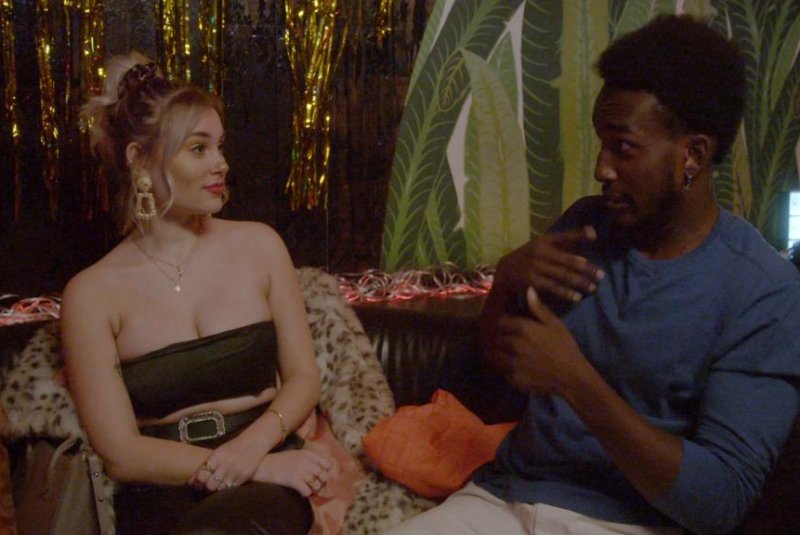1 of 4 | Cheyenna Clearbrook (L) and Rodney Burford attend Gallaudet University. Photo courtesy of Netflix
LOS ANGELES, Oct. 9 (UPI) -- Model, actor and deaf activist Nyle DiMarco wants viewers to see that deaf people are no different than they are. His latest project, the Netflix docuseries Deaf U, invites viewers onto the campus of his alma mater, Gallaudet University for the deaf and hard of hearing, in Washington, D.C.
"Deaf people are human, the same as hearing people," DiMarco said on a recent Television Critics Association panel. "We go through the same things in life."
DiMarco made history as the first deaf winner of America's Next Top Model, and was the second deaf Dancing with the Stars winner after Marlee Matlin. He graduated from Gallaudet in 2013. As executive producer of Deaf U, DiMarco said he wants to tell the stories of current students he met when he visited campus.
The students who participated in Deaf U have the same goal as DiMarco.
"One thing that I think people will learn is that deaf people can do what you all do," Rodney Burford, a psychology major, said via an interpreter. "The only thing we can't do is hear. That's all."
The series follows students during the 2018-2019 school year at the university, taking classes, studying, playing sports, socializing and having relationships.
As Cheyenna Clearbrook, a history and anthropology major, pointed out, the deaf community at Gallaudet complements the traditional college experience.
"There's such a plethora of things that we can do," Clearbrook said. "People will be able to enjoy watching us and knowing that we have the same experiences in college, just like a hearing person."
Renate Rose -- a double major in government and law and international studies, plus a minor in communication studies -- said the size of the deaf community on the Gallaudet campus is unique. However, within the deaf community, the subsets and individual stories mirror traditional campuses.
"We have our own background," Rose said. "We have our own culture. We have our own preferences, along with the deaf culture and communities. So, it really is just a mesh."
The student body of Gallaudet includes LGBTQ and straight students, as well as Black, White, Latinx and indigenous students. Rose was dating Talya in the semesters Deaf U filmed, while Burford chased various women.
DiMarco said the students on whom Deaf U focused demonstrate the gamut of different experiences within the deaf community.
"I think the hearing community often looks at deaf people and the deaf experience as monochromatic or a monolith," DiMarco said. "That simply isn't true."
Levels of hearing and speaking also distinguish subsets within Gallaudet. Some deaf students still speak or vocalize, while others shout and others remain quiet while they sign.
Those who use cochlear implants or regular hearing aids are distinct from those who use no devices. Some students consider others "deaf elite" if their families have been deaf for generations and had the money to attend specialized schools for the deaf before Gallaudet.
"You'll see some people come into Gallaudet with incredible signing skills after going to deaf schools for so long," DiMarco said. "Some people are just finding them, and I think this project really shows that."
Daequan Taylor, a graduate with a bachelor's degree in physical education, was born able to hear and became deaf after a seizure at age 6. He grew up in a hearing family and community, but Gallaudet offered his first chance to learn American Sign Language. Taylor says it took him his freshman and sophomore years to master ASL.
"For me, going to a deaf school with no background of deafness, being exposed to deaf culture for the first time, I really wanted to show people my struggles," Taylor said.
Other Gallaudet students like Clearbrook and Rose grew up using sign language with their deaf and hearing family members. Clearbrook says she was "mainstreamed," meaning she went to schools for children who could hear and had to adapt to the hearing world.
For Rose and Clearbrook, Gallaudet was the first community they experienced that did not require them to function in a hearing world. In Deaf U's footage, the viewer can hear birds chirping as students like Rose sign with their friends on campus.
"Seeing such a huge deaf community with so much diversity was really eye-opening for me," Rose said.
In addition to subsets within the campus, Clearbrook said the individual backgrounds of the college community were meaningful, too. The individual stories of Gallaudet students were just as important to Burford.
"I'm representing myself," Burford said. "I can't represent any other university, but I could just show you who I am."
Gallaudet's community also includes people with different levels of hearing loss. Taylor only lost hearing in his left ear.
"I can't say I represent all of Gallaudet, of course, because I'm not fully deaf," Taylor said.
The only aspect of Deaf U that made the Gallaudet experience different for the cast was the use of cameras. Rose said her friends supported the filming and adapted to having cameras around. Burford said it took some time for him to adjust to cameras constantly following him.
"The first week was a little rough, I have to admit," Burford said.
The Netflix crew made sure not to interfere with their subjects' studies.
"I don't really think [filming] affected most of our study time," Clearbrook said. "We were still able to focus on the studies."
Deaf U premieres Friday on Netflix.















